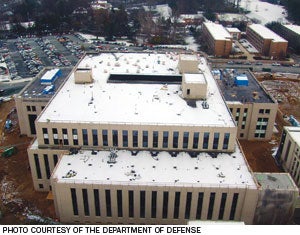Department of Defense projects aim to transform military health care
Two active wars, thousands of wounded soldiers, aging facilities and base consolidation have propelled the biggest program of military hospital and clinic construction in recent history.
 |
| The Walter Reed National Military Medical Center will be a tri-service facility built on the Bethesda, Md., campus of the current National Naval Medical Center. |
The Department of Defense (DoD), which operates 59 hospitals worldwide, currently is building or renovating seven hospitals nationwide, in some cases replacing or expanding old facilities it's shutting down or merging. More hospitals are in the planning stages, pending congressional approval.
The Pentagon is tapping $2.5 billion in new funding Congress provided under the 2005 Base Realignment and Closure Act, $1.3 billion in supplemental appropriations in 2008 and 2009, and another $1.3 billion under the economic stimulus bill, in addition to its regular $250 million capital budget for health care. DoD has requested an additional
$1 billion for 2010.
"This is an unprecedented time of military health care construction," says Dennis Thompson, president of the western region of Walton Construction Co., which recently won a contract with Balfour Beatty Construction to build the new, $334 million Irwin Army Community Hospital at Fort Riley in Kansas, replacing the Army's oldest hospital.
In the Washington, D.C., area, DoD is building the new, 345-bed Walter Reed National Military Medical Center, a research and teaching facility in Bethesda, Md., and the 120-bed Fort Belvoir Community Hospital, plus extensive ambulatory clinics, in northern Virginia. In the San Antonio area, DoD is erecting the San Antonio Military Medical Center, consolidating its two hospitals there and expanding research and training at Fort Sam Houston.
Other large replacement hospitals are in development at Fort Hood and Fort Bliss in Texas, Fort Benning in Georgia, Camp Lejeune in North Carolina, Camp Pendleton in California and the Wright-Patterson Air Force Base in Ohio. New clinics are being constructed at many other bases around the country.
The Pentagon is working with health design experts to incorporate features that enhance care. "We aren't just trying to build more buildings but the right buildings," says Clay Boenecke, capital planning chief in the Office of the Assistant Secretary of Defense for Health Affairs.
The military has developed a set of design principles that will be embedded in the new hospitals, such as making patients' families part of the care process, says Craig Zimring, a Georgia Tech University architecture professor who is working with the military to upgrade its hospitals and clinics.
Zimring and his colleagues are helping set up a process to study each new military hospital after it opens to determine whether it's achieving expected quality outcomes. They also will be studying patient falls and other adverse incidents at the four existing military hospitals in the Washington, D.C., area, then comparing those outcomes to the two new hospitals.
In addition to quality advances, the military is using newer contracting and design approaches borrowed from the private sector. On many projects, for example, the military has adopted the design-build model, says Mitch Hoefer, of Hoefer Wysocki Architects in Kansas City, Mo., which is working on a number of military clinics.
The U.S. military is "in the process of transforming military health care," Zimring concludes.




